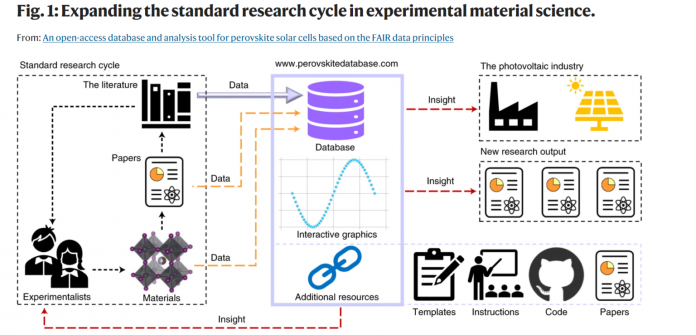For a research field to benefit from previous findings, there are a surprising number of challenges: inconsistent formatting, undocumented storage or improper dissemination can all make it difficult for new researchers to navigate the state of the art. Now 95 experts from more than 30 international research institutions have designed a database to systematically record findings from peer-reviewed papers on metal-halide perovskite solar cells.
In recent years, research on halide perovskites has boomed resulting in a flood of data scattered over an inaccessibly large and ever-increasing number of papers. In spring this year, when the researchers started writing their paper titled An open-access database and analysis tool for perovskite solar cells based on the FAIR data principles, published in the journal Nature Energy, more than 19,000 publications had already been entered in the Web of Science under the keyword “perovskite solar”.
The Perovskite Database Project is open source and provides an overview of the rapidly growing knowledge as well as the open questions in this exciting research field. The researchers have manually gone through every paper found in the Web of Science with the search phrase “perovskite solar” up to the end of Feb. 2020 (that is, over 15,000 papers) and extracted data for over 42,400 PV devices with up to 100 parameters per device.
These devices represent almost every device someone has thought worth the effort to describe in detail anywhere in peer-reviewed literature, displaying the halide perovskites’ huge potential for solar cells and other optoelectronic applications. The database also sheds light on the remaining problems in this field related to, for example, stability, scalability, and reliability; as well as open questions related to the best material combinations and manufacturing processes, and discussions regarding key standards and metrics.
Apart from organizing all historical data according to the FAIR principles, so they are findable, accessible, interoperable, and reusable, the Perovskite Database Project also provides means to upload new experimental data and features interactive graphical data visualization tools that enable simple and interactive exploration, analysis and filtering.
The database, graphics, and analysis tools are made available to the community and will continue to evolve as an open-source initiative. The researchers argue that this approach of extensively capturing the progress of an entire field, including sorting, interactive exploration, and graphical representation of the data, and that it will be applicable to many fields in materials science, engineering, and biosciences.






